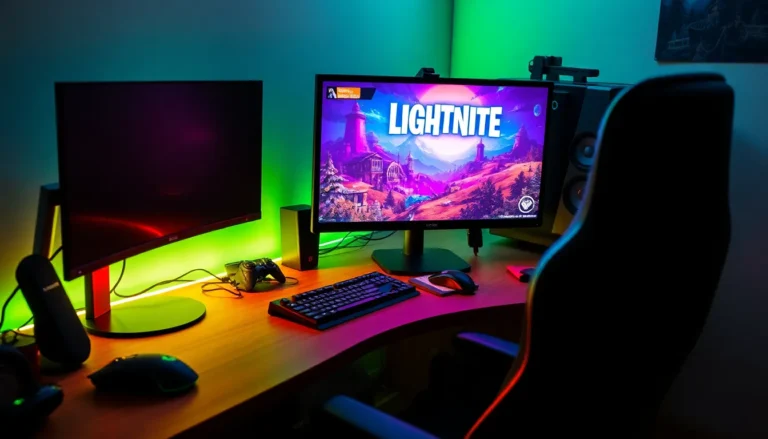Table of Contents
ToggleIn the fast-paced world of computer-aided design, having the right laptop can make or break a project. Imagine trying to design the next architectural marvel on a sluggish machine that freezes more often than a deer in headlights. It’s not just frustrating; it’s a recipe for disaster. Thankfully, not all laptops are created equal, and some are specifically engineered to handle the demanding needs of CAD software.
From sleek designs to powerhouse performance, the best laptops for CAD combine speed, graphics, and reliability. Whether you’re drafting blueprints or rendering 3D models, the right laptop can turn your creative visions into reality without the drama of constant crashes. So, let’s dive into the top contenders that’ll have you zooming through your projects like a pro, all while keeping your sanity intact.
Overview of CAD Laptops
Selecting an appropriate laptop for computer-aided design involves specific technical requirements. High-performance processors significantly impact overall design efficiency. Designers often rely on powerful graphics cards to handle complex 3D models and rendering tasks. Adequate RAM also plays a crucial role, with 16GB being a common baseline for smooth multitasking and performance.
Screen resolution is essential for those working on intricate designs. Laptops offering at least 1920 x 1080 (Full HD) resolution provide clarity and detail. Portability matters, too; many professionals prefer lightweight models that maintain high performance without sacrificing mobility.
Battery life becomes critical during extended design sessions. A laptop that provides 6 to 8 hours of runtime is often favored to enable uninterrupted work. Storage options should include SSDs as they enhance loading speeds and overall performance.
Compatibility with CAD software requires attention, as not all laptops support every program equally. Researching software recommendations ensures seamless integration of hardware and applications. Brands recognized for producing reliable CAD laptops often include Dell, HP, and Lenovo.
Cost-effectiveness is another aspect to consider. While high-end specifications can increase prices, finding a balance between suitable features and budget constraints can lead to a worthwhile investment. Users benefit from exploring various models that match their specific CAD needs.
Key Features to Consider

Selecting the right laptop for CAD work involves a focus on essential features. Prioritizing performance attributes ensures efficiency in design tasks.
Processing Power
Processing power remains vital for CAD laptops. Look for models equipped with Intel Core i7 or Ryzen 7 processors. These processors deliver the speed necessary for complex calculations and multitasking. Optimally, CPUs with multiple cores enhance productivity when handling intricate designs. Performance benchmarks show that higher clock speeds positively impact rendering times. Models with processing capabilities above 2.5 GHz significantly reduce lag during operations.
Graphics Performance
Graphics performance serves as a cornerstone for effective CAD applications. Dedicated graphics cards, such as NVIDIA GTX or RTX series, provide the necessary rendering capabilities. Opting for at least 4GB of VRAM enhances the experience when working with 3D models. These GPUs accelerate the rendering process, making transitions smoother. Users can expect faster visualization of designs, which saves time and reduces frustration. Higher performance graphics cards improve clarity and detail, essential for intricate work.
RAM and Storage
RAM and storage contribute significantly to overall performance. A minimum of 16GB of RAM ensures smooth multitasking and efficient handling of large files. Models equipped with 32GB are ideal for demanding projects involving intricate designs. Storage plays an equally important role; solid-state drives (SSDs) deliver quick data access and boot times. High-capacity SSD options, such as 512GB or 1TB, prevent bottlenecks when saving or loading extensive projects. Speed and reliability in storage contribute to a fluid CAD experience, enhancing productivity.
Top Picks for Best Laptops for CAD
This section highlights top laptops that excel in computer-aided design. Each recommended model delivers the power, graphics, and reliability essential for CAD professionals.
Laptop 1: Dell Precision 7550
Dell’s Precision 7550 features an Intel Core i7 processor, ensuring strong performance for demanding applications. Equipped with an NVIDIA RTX 3000 graphics card, it provides exceptional rendering capabilities, perfect for complex 3D models. This model includes 32GB of RAM, allowing seamless multitasking during intensive design projects. Users benefit from a 15.6-inch 4K UHD display, offering crisp visuals essential for intricate designs. Furthermore, its 1TB SSD enhances data access speed, significantly improving productivity.
Laptop 2: HP ZBook Fury 15 G7
HP’s ZBook Fury 15 G7 stands out with a powerful Intel Core i7 CPU paired with NVIDIA RTX 4000 graphics. The laptop boasts 32GB of RAM, which facilitates efficient handling of large files and applications. Adequate storage is provided by a 1TB SSD, optimizing load times and performance. With a 15.6-inch Full HD screen, users enjoy clear detail while working on CAD projects. This model’s combination of hardware components makes it a top choice for professionals requiring reliability and speed.
Laptop 3: Lenovo ThinkPad P53
Lenovo’s ThinkPad P53 offers an Intel Xeon processor, designed for heavy computational tasks in CAD software. Featuring an NVIDIA Quadro T1000 graphics card, it enhances the visualization of complex designs significantly. For memory, 16GB of RAM comes standard, providing ample support for multitasking. Users can exploit the 15.6-inch Full HD display that delivers accurate colors and sharp images. A 512GB SSD ensures quick access to files, making it a competent option for CAD specialists.
User Experience and Performance
User experience and performance significantly influence the effectiveness of laptops for CAD work. High-performance laptops, such as those with Intel Core i7 or Ryzen 7 processors, provide the necessary speed for complex calculations. Models featuring dedicated graphics cards like NVIDIA GTX or RTX series enhance rendering capabilities, enabling smooth visualization of intricate 3D models.
Performance also depends on RAM capacity. A minimum of 16GB ensures efficient multitasking without lag during substantial CAD projects. Storage plays a vital role as well, with SSDs vastly improving data access speed compared to traditional HDDs. Quick loading times facilitate a more fluid user experience when working with large files.
Screen resolution matters for clarity in design work. Laptops boasting at least 1920 x 1080 (Full HD) display sharp, detailed images, making it easier to focus on precision while drafting. Additionally, portability is crucial for those on the move, and models that offer lightweight designs can easily transition between workspaces.
Battery life should not be overlooked. CAD professionals benefit from laptops that can sustain long hours of work without frequent recharges. Several top models, including the Dell Precision 7550 and HP ZBook Fury 15 G7, provide powerful performance along with impressive battery longevity.
Keyboard comfort affects productivity significantly. Ergonomic keyboards can support extended periods of use, minimizing strain and fatigue. Evaluating the overall build quality also contributes to a positive user experience, as sturdier designs ensure longevity even under rigorous use.
Compatibility with various CAD software enhances usability. Laptops optimized for specific software can maximize performance, ensuring users experience the full capacity of their tools. Exploring options from trusted brands like Dell, HP, and Lenovo often leads to finding reliable machines tailored to CAD professionals’ needs.
Choosing the right laptop for CAD work is crucial for achieving optimal performance and productivity. With the right specifications and features, professionals can tackle complex designs and renderings without interruption. Brands like Dell, HP, and Lenovo offer models that meet the demanding requirements of CAD software.
By focusing on processing power, dedicated graphics, sufficient RAM, and storage options, users can ensure a smooth workflow. Investing in a reliable laptop tailored for CAD can significantly enhance the design experience. Ultimately, the right choice will empower designers to bring their visions to life efficiently and effectively.





